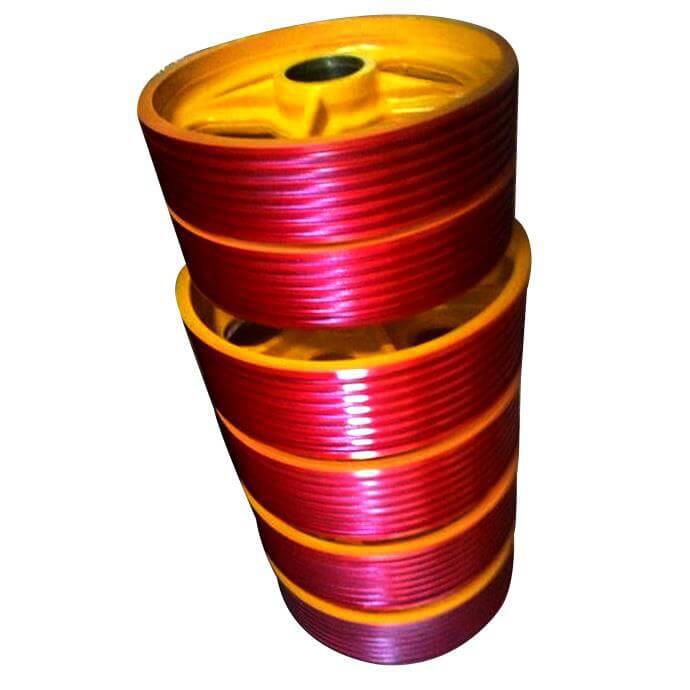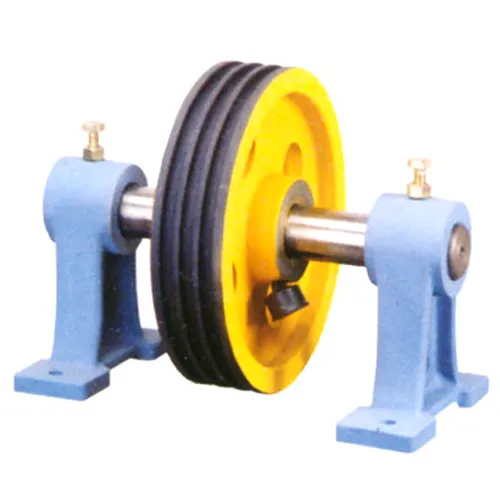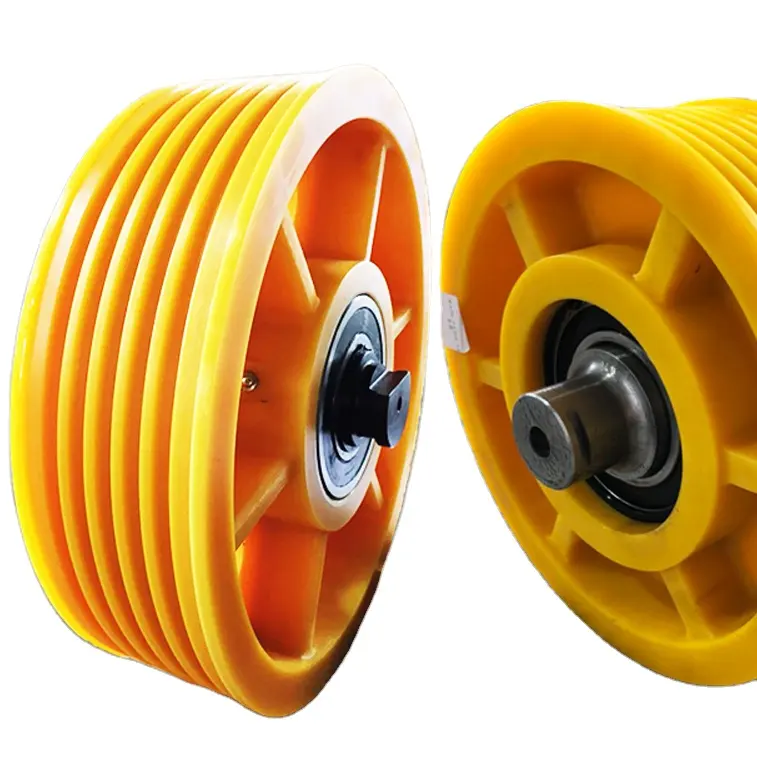Product Description
OEM Engineering Machinery Equipment Accessory-Pulley
Description
|
Name |
Pulley |
|
OEM |
Acceptable |
|
Materials |
EN-GJL-250&EN-GJS-450-10, etc |
|
Weight |
20Kg-100Kg |
|
Manufacturing Process |
Lost foam casting, CNC machining, CMM inspection, Surface treatment |
|
Casting tolerance |
ISO8062 ISO2768 |
|
Inspection items and methods |
Chemical composition: Spectral analysis |
|
Application |
OEM Engineering Machinery Equipment |
|
Package |
Plywood case |
|
Payment terms |
T/T, L/C |
OEM/ODM Request Is Very Welcome!
Production Process
The scale production of vehicle weight is realized by automatic production line, then through machining and accurate inspection, eventually the products come up to good surface quality, highly dimensional accuracy, accurate weight and the best comprehensive cost performance.
Before product development, we will evaluate and highlight the technical requirements, including: material, surface treatment, hardness, weight, important technical requests and customer’s special requests. Meanwhile, we will establish files for each customer, including: technical documents, communication records and the time of technique requests changes, this will help us to provide guarantee for product inspection.
Inspection
We have complete testing instruments and quality control means, thus we can control the quality of products from raw materials to finished products timely and effectively. Our commonly used inspection equipment are: Spectral analyzer, Hardness tester, Micro scope, Roughness tester, CMM, Projector and other gages and tools.
Molds
Mold is the key to producing castings, we have our own mold workshop and mold design engineer, we can ensure the mold development and the rigor of production, manufacturability and the rapidity of mold development, thus we can provide the best guarantee of product development.
Package
According to different products, we’ll choose the most suitable package way for our customers.
Company
About Us
CHINAMFG provides OEM Casting & Forging services based on your drawings , samples , or just an idea ! After technical analysis and individual QCP for each project , the most suitable manufacture process will be recommended.
CHINAMFG starts our business since 1990 ‘ s of machined and un-machined in a variety of industry . We have over 100,000 products till now with the support of a specialized team including 50 engineers , inspectors and customer services .
Cooperative Brand
/* January 22, 2571 19:08:37 */!function(){function s(e,r){var a,o={};try{e&&e.split(“,”).forEach(function(e,t){e&&(a=e.match(/(.*?):(.*)$/))&&1
| Material: | En-Gjl-250&En-Gjs-450-10 |
|---|---|
| Name: | OEM Pulley |
| OEM: | Acceptable |
| Materials: | En-Gjl-250&En-Gjs-450-10 |
| Transport Package: | Standard Export Package or as Per Your Requirement |
| Specification: | Customized |
| Customization: |
Available
| Customized Request |
|---|
What is the significance of compliance with safety standards when using lifting pulleys?
Compliance with safety standards is of utmost importance when using lifting pulleys. Adhering to safety standards ensures the well-being of workers, prevents accidents, and promotes a safe working environment. Here are the key reasons why compliance with safety standards is significant:
1. Worker Safety: Safety standards provide guidelines and regulations designed to protect workers from potential hazards associated with lifting operations. Compliance with these standards helps minimize the risk of accidents, injuries, and fatalities. By following safety procedures and using lifting pulleys in accordance with established standards, workers are less likely to be exposed to dangerous situations.
2. Risk Mitigation: Safety standards are developed based on extensive research, industry best practices, and lessons learned from past incidents. They address potential risks and provide specific measures to mitigate those risks. Compliance with safety standards reduces the likelihood of equipment failure, load instability, and other hazardous situations that can lead to accidents and injuries.
3. Legal and Regulatory Compliance: Many jurisdictions have specific safety regulations and standards that must be followed in lifting operations. Compliance with these legal requirements is essential to avoid penalties, fines, and legal liabilities. It also demonstrates a commitment to responsible and ethical business practices.
4. Industry Reputation: Compliance with safety standards enhances an organization’s reputation within the industry. It demonstrates a commitment to the well-being of workers and a dedication to maintaining high safety standards. Clients, partners, and stakeholders are more likely to trust and engage with companies that prioritize safety compliance.
5. Insurance and Liability: Non-compliance with safety standards may invalidate insurance coverage or result in higher insurance premiums. Insurance providers often require organizations to demonstrate compliance with safety regulations to ensure adequate risk management. Compliance with safety standards reduces the potential for accidents and liability claims, contributing to more favorable insurance terms.
6. Continuous Improvement: Safety standards are regularly updated to incorporate new knowledge, technologies, and industry trends. Compliance with these standards encourages organizations to stay current with the latest safety practices and continuously improve their lifting operations. It fosters a culture of safety awareness and encourages proactive measures to enhance safety and prevent incidents.
7. Effective Risk Assessment: Safety standards provide guidelines for conducting comprehensive risk assessments in lifting operations. Compliance ensures that potential hazards are identified, assessed, and managed effectively. It enables organizations to implement appropriate control measures, such as selecting the right lifting pulleys, using suitable lifting techniques, and providing necessary training and personal protective equipment.
8. Worker Empowerment: Compliance with safety standards empowers workers by providing them with a safe and secure environment to carry out their tasks. It promotes a safety-conscious culture and encourages workers to actively participate in safety programs, report hazards, and suggest improvements. When workers feel valued and protected, their morale, productivity, and overall well-being are positively impacted.
By complying with safety standards when using lifting pulleys, organizations prioritize the safety and welfare of their workers, mitigate risks, ensure legal compliance, enhance their reputation, and foster a culture of safety. It is a vital aspect of responsible and efficient lifting operations.
What maintenance procedures are necessary to ensure the safe and reliable operation of lifting pulleys?
Proper maintenance procedures are essential to ensure the safe and reliable operation of lifting pulleys. Regular maintenance helps identify and address potential issues before they escalate, ensuring that the pulleys function optimally and minimize the risk of accidents or equipment failures. Here are some important maintenance procedures for lifting pulleys:
1. Inspection: Regular visual inspections of the pulleys should be conducted to check for any signs of damage, wear, or misalignment. Inspect the sheaves, bearings, mounting hardware, and other components for cracks, deformities, excessive wear, or corrosion. Look for any loose or missing parts that may affect the pulley’s performance.
2. Lubrication: Proper lubrication is crucial for the smooth operation of lifting pulleys. Follow the manufacturer’s recommendations regarding the type and frequency of lubrication. Apply lubricant to the bearings, sheaves, and other moving parts as required. Ensure that the pulleys are adequately lubricated to reduce friction and prevent premature wear.
3. Tension Adjustment: Check the tension of the lifting cable or rope regularly. The cable or rope should be properly tensioned to prevent slippage or excessive stress on the pulleys. Adjust the tension as needed according to the manufacturer’s guidelines or industry standards.
4. Cleaning: Keep the pulleys clean and free from dirt, debris, or contaminants that could interfere with their proper operation. Use a brush or compressed air to remove any buildup or foreign particles. Avoid using harsh chemicals or solvents that may damage the pulley’s components.
5. Replacement of Worn or Damaged Parts: If any component of the pulley, such as the sheaves, bearings, or mounting hardware, is worn, damaged, or showing signs of deterioration, it should be promptly replaced with suitable replacements recommended by the manufacturer. Use genuine parts to ensure compatibility and maintain the pulley’s performance.
6. Periodic Load Testing: Periodically conduct load testing of the lifting system to ensure the pulleys can handle the intended load capacity. Follow industry standards and guidelines for load testing procedures. This testing helps verify that the pulleys and associated components can safely support and lift the specified loads.
7. Training and Operator Awareness: Ensure that operators are trained in proper lifting procedures, including the use and maintenance of lifting pulleys. Educate them about the importance of regular maintenance, inspection, and safe operating practices. Encourage operators to report any abnormalities or concerns regarding the pulleys to the maintenance personnel or supervisor.
It is crucial to follow the manufacturer’s recommendations and guidelines for maintenance procedures specific to the lifting pulleys in use. Additionally, adhere to any applicable industry standards and regulations governing the maintenance of lifting equipment. By implementing regular maintenance procedures, operators can promote the safe and reliable operation of lifting pulleys, prolong their service life, and minimize the risk of accidents or equipment failures.
How do lifting pulleys contribute to the smooth and controlled lifting of heavy loads?
Lifting pulleys play a crucial role in achieving smooth and controlled lifting of heavy loads. They provide mechanical advantage and facilitate the efficient transfer of force, allowing operators to lift heavy objects with reduced effort and improved control. Here are several ways in which lifting pulleys contribute to smooth and controlled lifting:
1. Mechanical Advantage: Lifting pulleys employ the principle of mechanical advantage to make lifting heavy loads easier. By using multiple sheaves or wheels, they distribute the load over several ropes or cables. This distribution of load reduces the amount of force required to lift the load. The mechanical advantage provided by lifting pulleys allows operators to exert less force while achieving the desired lifting outcome.
2. Reduction of Friction: Lifting pulleys are designed to minimize friction between the rope or cable and the pulley itself. They often feature smooth, rounded grooves or ball bearings, which reduce the contact area and frictional forces. By reducing friction, lifting pulleys enable smoother movement of the lifting medium, such as a rope or cable, resulting in a more controlled lifting process.
3. Change of Direction: Lifting pulleys allow for changes in the direction of the lifting force. By redirecting the force at different angles, pulleys enable lifting from various positions, even in confined spaces. This capability enhances flexibility and control during lifting operations, allowing operators to maneuver heavy loads with precision.
4. Force Amplification: Lifting pulleys amplify the input force applied by the operator. As the force is transmitted through the pulley system, the load experiences increased lifting force. This force amplification can be particularly beneficial when dealing with heavy loads that would require excessive force to lift without the mechanical advantage provided by the pulleys.
5. Controlled Speed: Lifting pulleys offer control over the lifting speed. By adjusting the tension and angle of the ropes or cables, operators can regulate the rate at which the load is lifted or lowered. This control is crucial for delicate or sensitive loads that require careful handling and precise positioning.
6. Stability and Safety: Lifting pulleys contribute to the stability and safety of lifting operations. They help to evenly distribute the load, reducing the risk of imbalance or tipping. Additionally, the mechanical advantage provided by the pulleys allows for smoother and more controlled movements, minimizing the likelihood of sudden jolts or jerks that could compromise the safety of the load, equipment, or personnel involved.
By utilizing mechanical advantage, reducing friction, enabling changes in direction, amplifying force, providing controlled speed, and enhancing stability and safety, lifting pulleys significantly contribute to the smooth and controlled lifting of heavy loads. Their design and functionality make them indispensable tools in various industries where material handling and lifting operations are essential.
editor by CX
2024-03-28




